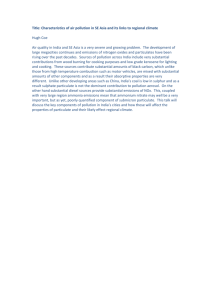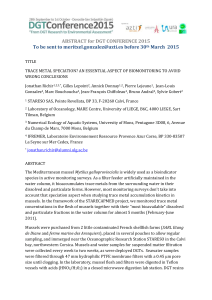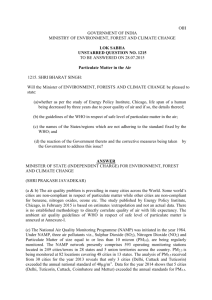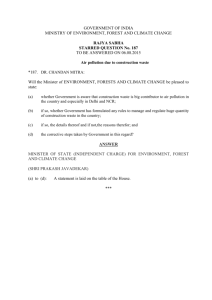Source Identification of Trace Metal in Total Suspended Particulate
advertisement
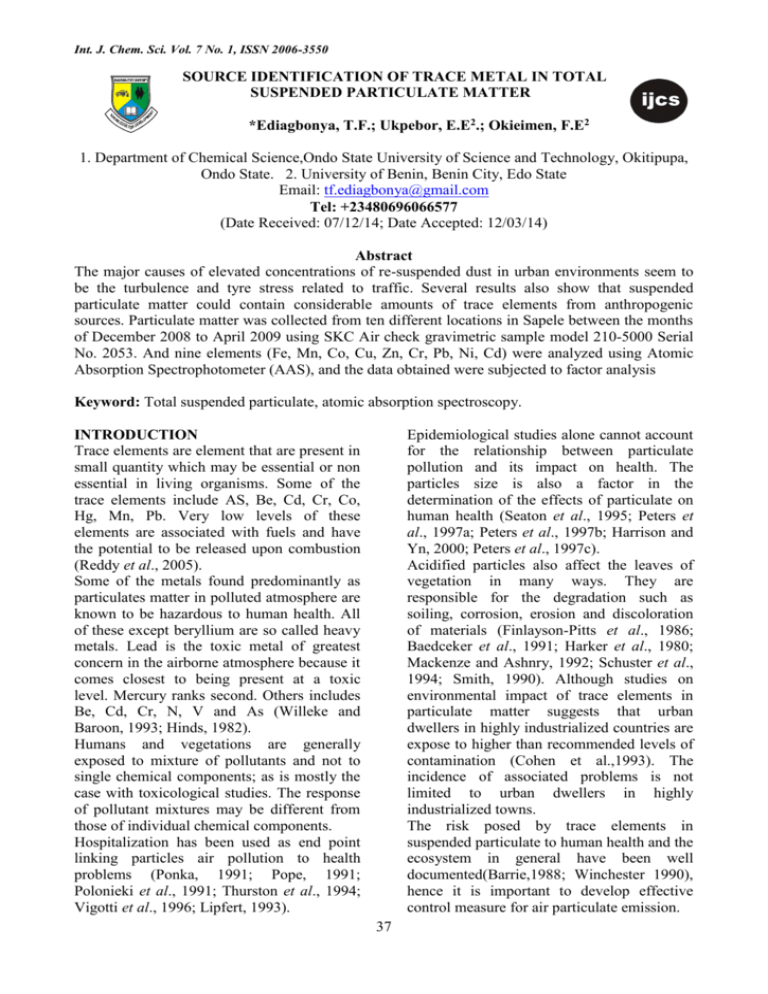
Int. J. Chem. Sci. Vol. 7 No. 1, ISSN 2006-3550 SOURCE IDENTIFICATION OF TRACE METAL IN TOTAL SUSPENDED PARTICULATE MATTER ijcs *Ediagbonya, T.F.; Ukpebor, E.E2.; Okieimen, F.E2 1. Department of Chemical Science,Ondo State University of Science and Technology, Okitipupa, Ondo State. 2. University of Benin, Benin City, Edo State Email: tf.ediagbonya@gmail.com Tel: +23480696066577 (Date Received: 07/12/14; Date Accepted: 12/03/14) Abstract The major causes of elevated concentrations of re-suspended dust in urban environments seem to be the turbulence and tyre stress related to traffic. Several results also show that suspended particulate matter could contain considerable amounts of trace elements from anthropogenic sources. Particulate matter was collected from ten different locations in Sapele between the months of December 2008 to April 2009 using SKC Air check gravimetric sample model 210-5000 Serial No. 2053. And nine elements (Fe, Mn, Co, Cu, Zn, Cr, Pb, Ni, Cd) were analyzed using Atomic Absorption Spectrophotometer (AAS), and the data obtained were subjected to factor analysis Keyword: Total suspended particulate, atomic absorption spectroscopy. Epidemiological studies alone cannot account for the relationship between particulate pollution and its impact on health. The particles size is also a factor in the determination of the effects of particulate on human health (Seaton et al., 1995; Peters et al., 1997a; Peters et al., 1997b; Harrison and Yn, 2000; Peters et al., 1997c). Acidified particles also affect the leaves of vegetation in many ways. They are responsible for the degradation such as soiling, corrosion, erosion and discoloration of materials (Finlayson-Pitts et al., 1986; Baedceker et al., 1991; Harker et al., 1980; Mackenze and Ashnry, 1992; Schuster et al., 1994; Smith, 1990). Although studies on environmental impact of trace elements in particulate matter suggests that urban dwellers in highly industrialized countries are expose to higher than recommended levels of contamination (Cohen et al.,1993). The incidence of associated problems is not limited to urban dwellers in highly industrialized towns. The risk posed by trace elements in suspended particulate to human health and the ecosystem in general have been well documented(Barrie,1988; Winchester 1990), hence it is important to develop effective control measure for air particulate emission. INTRODUCTION Trace elements are element that are present in small quantity which may be essential or non essential in living organisms. Some of the trace elements include AS, Be, Cd, Cr, Co, Hg, Mn, Pb. Very low levels of these elements are associated with fuels and have the potential to be released upon combustion (Reddy et al., 2005). Some of the metals found predominantly as particulates matter in polluted atmosphere are known to be hazardous to human health. All of these except beryllium are so called heavy metals. Lead is the toxic metal of greatest concern in the airborne atmosphere because it comes closest to being present at a toxic level. Mercury ranks second. Others includes Be, Cd, Cr, N, V and As (Willeke and Baroon, 1993; Hinds, 1982). Humans and vegetations are generally exposed to mixture of pollutants and not to single chemical components; as is mostly the case with toxicological studies. The response of pollutant mixtures may be different from those of individual chemical components. Hospitalization has been used as end point linking particles air pollution to health problems (Ponka, 1991; Pope, 1991; Polonieki et al., 1991; Thurston et al., 1994; Vigotti et al., 1996; Lipfert, 1993). 37 Int. J. Chem. Sci. Vol. 7 No. 1, pp 37-45, 2015 Objectives of this study are to analyze the glass fiber filter for certain trace metals (Zn, Cu, Mn, Ni, Co, Pb, Fe, and Cr) and to identify those elements which are abnormally enriched in the atmosphere as well as differentiate sources of the elements. Some of these metals are well known to cause chronic and acute poisoning of important organ in the body, cancer, dermatitis and ulcers of the skin, Benign pneumoconiosis, manganese poisoning and cause damage of mucous membrane) and silicosis(NIOSH,2002;Park et al., 1999;IARC 1997;Mohebbi and AbdRad,2007). These metals enter the atmosphere from both anthropogenic and biogenic sources. This study area is located within the coordinates of latitude 0050 50’ 0”- 0050560”N and longitude 005037’0” – 005045’00E. The study area has a total aerial extent of 165.25 square kilometers. MATERIALS AND METHODS AREA OF STUDY The town Sapele is situated in the south-south geopolitical region of Nigeria with a population of about 135,800 (NPC, 2005/2006). It was once an integral part of the old western region of Nigeria. It is presently a part of Delta State of Nigeria created in August 27, 1991, after having been part of the defunct Mid Western State (19631976) and the defunct Bendel State (19761991) The major activities among the people of Sapele that generate particulate pollution are usually bush burning as a pre planting preparation, combustion of solid waste as a means of waste disposal, gas flaring, resuspension of dust from unpaved road, and the production of charcoal which involves the burning of wood in an open space from dawn till dusk in four different locations in the city. These charcoal are usually exported to other countries and sometime nearby cities. Sapele is located near the junction of Jamieson and Ethiope rivers and about 80 mile (144 kilometers) from the sea, well closer into the timber yielding forest of the interior. Sapele is one of the first-rate wood industries in this region. However, it is a commercial city with four petroleum and allied industries. The climate is tropical with two distinct seasons, wet and dry. 50 30E 60 30E 60 00N 60 00N Koko Benin River NIGERIA Ajagbodudu (Aronwon) Ununean Oghareki Befruno Study Area NEPA Ogorode Ogharefe Ajajigwor Ogalo Naval Base Arone Oton Ugbekoko Well Mech. Village To Benin Ganna River Mkt O K P E U Adeola Okpe Rd R H O B O F Mayuku Old Sec O Stadium R S E T Adaka R E RiVER S E R Ugborh eVE Olympia LEGEND Jermison Warri Sapele Rd AT&P Ajimele Major roads Ugbeyiyi Amuogbodo Magibason Reclamasion River Okirighwre New Sec Police Station Adagbrasa Igbeku Settlements Amukpe Ado Eku Sample Location Okuovwori Obaisajere Ogegere Amukpe Songhai 0 Umeru Ajekimo ni 60 45N 50 30E 60 45N 60 30E Fig.1 Map of Sapele showing the various Sampling locations 38 1 SCALE 2Km Source Identification of Trace Metal in Total Suspended Particulate Matter Table 1: Showing the site coordinates and description S/N 1 Site code SP.MV 2 SP.SG 3 SP.NOR 4 SP.RH 5 SP.OJ 6 SP.SM 7 SP.IA 8 SP.NER 9 SP.SWR 10 SP.OK Co-ordinates N0551’53.5” E00541’39.0” N0551’025” E005441.37.4” N0551’06.3” E005 44’45.4” N0551’.33.” E00543’06.4” N0553’24.8” E00540’4.9” N0554’05.9” E00541’8.9” N0555’16.8” E00538’48.5” N0552’28.6” E00542’07.8” N0552’28.6” E00542’07.8” N0552’27.0” E00543’40.7” Site description The site was created at the mechanic village (shell Rd) This was created at the Songhai The site was created at new Ogorode Road. The site was created at residential houses in Amoukpe area The site was created at Olympia Junction The site was created at Sapele market The site was created at the industrial area This was created at New Eku Road The site was created at Warri Sapele Road The site was created at Okirighwere In line with the objectives of the study, ten monitoring sites were carefully selected to represent all the quarters of the city with high air pollution sources. These sites were created within the vicinities to reflect variation in traffic volume and human activities. Table 1 represents the monitoring sites and their coordinates. The monitoring sites were Georeferenced by using Garmin GPS MAP 765 chart plotting receiver. Sample Digestion and Measurement; The trace metals Ph, Cd, Ni, Cu, Co, Fe, Zn, Cr and Mn were determined by AAS (Thermo electron corporation Atomic Absorption spectrometry, S. Series) A portion of the effective filter was digested with 20ml 1:1 HNO3 in a beaker and covered with a watch glass which was concentrated to about 5ml on a hot plate at 150-1800C 10ml of 1:1 HNO3 was added to repeat it. The extract was filtered through a 541 filter paper, the filter paper and the beaker was washed with 0.25M HNO3. The filtrate was transferred and weighted into 50ml volumetric flask. The chemical and reagents used for analysis were analar grade. Data Analysis The results got from this work were subjected to descriptive statistics and enrichment factor computation. In this work, Iron was chosen as the reference element during the computation of enrichment factor. Jian and Ukuo used Iron as a reference (Ediagbonya et al., 2013;JianZheng et al., 2004) Sample Collection: SKC Air Check XR5000 high volume Gravimetric model 210-5000 serial No. 20537 with a what- man glass fiber filter was used to capture the particles. The particles were collected at a flow rate of 2l/min for eight hours and the sampler was placed between the heights of 1.5-2m of human. What man glass fibers used was conditioned in a controlled room temperature for at least 24hrs before pre-and post weighting. The sampling was done from Dec. 2008-April 2009. 39 Int. J. Chem. Sci. Vol. 7 No. 1, pp 37-45, 2015 C1 CFe TSP Table 3 shows the mean concentration of the elemental composition of the various locations. The total mean concentration values of the analysed trace metals follow the order: Pb > Fe > Cd > Cr > Mn > Cu > Zn. while Ni and Co were below the detection limit. C1 CFe crust Where C1 the concentration of the element is considered in the TSP of the crust and CFe is the concentration of the reference element (Fe). The elemental concentration in the crust used in this study was got from Aynan et al 2014. An enrichment factor close to 1 indicates that the relative concentration of a given element is identical to that which is present in the soil. An enrichment factor greater than 1 indicates that the element is more abundant in the air relative to that found in the soil, while values less than 1 suggests a depletion of the element in the air over that found in soil. In this work, iron was chosen as the reference element during the computation of the enrichment factor. (Jianzherg et al., 2004; Ediagbonya et al., 2013) From Table 3, Cd was highly enriched and Pb was moderately enriched. The trace metal concentration of other work done in other part of the country is comparable to this study. Typical concentration of some trace metals in air concentration range are shown in Table 4 Source Identification Of Total Suspended Particulate Matter. In an essay to find a common metal source, factor analysis was carried out which includes inter elemental correlation coefficient of metal concentration and principal component analysis with varimax rotation and cluster analysis. Table 2 shows the correlation coefficient of the metal concentration. RESULTS AND DISCUSSION In addition to particulate matter mass limit values which are based on health impact, recent European Union(EU) Standard target(As, Cd, Ni, Pb) limit for metals 6ng/m3 for As, 5ng/m3 for Cd, 20ng/m3 for Ni and 500ng/m3 for Pb. Table 2: The Correlation Coefficient of the Trace Metals Fe Zn Cu Mn Fe 1.00 Zn -0.03 1.00 Cu 0.31 -0.37 1.00 Mn -0.83 0.25 -0.43 1.00 Cd 0.24 0.06 -0.23 0.08 Pb 0.29 -0.44 0.96 -0.29 Cr 0.44 -0.60 0.12 -0.25 Cd Pb Cr 1.00 -0.13 0.70 1.00 0.27 1.00 From the PCA with varimax rotation, three components were extracted which explained 87.35% of the total variance 40 Source Identification of Trace Metal in Total Suspended Particulate Matter Table 3: The Principal Component Matrix of Trace Metals. Component Fe Zn Cu Mn Cd Pb Cr 1 0.07 -0.75 0.86 -0.24 -0.24 0.90 0.32 The rotated component matrix showed that from the three components extracted from PCA Cu and Cd loaded positively with the first component, while Zn and Pb loaded negatively with the first component. For the second component Fe, Mn and Cr loaded 2 0.95 0.10 0.33 -0.90 0.07 0.23 0.19 3 0.24 -0.38 -0.20 0.00 0.87 -0.05 0.92 positively. The three major sources of pollution were: Vehicular related emission, Biomass burning and solid waste incineration. This is showed in the rotated component plot as showed in Fig 2. Below. Fig 2. Component Plot in Rotated Space Cluster Analysis 41 Int. J. Chem. Sci. Vol. 7 No. 1, pp 37-45, 2015 This consists of splitting a data set into several dominant groups. It is frequently applied in air pollution research to find out pollutant source region. The clustering approach proposed by ( Dorling et al., 1992) factor analysis data generated were subjected cluster analysis. The Hierarchical cluster in Fig 3 confirmed three major clusters arrangement of the distribution of the ten monitoring sites. Cluster 1 comprises of Sites 3, 5 and 1, while cluster 2 comprises of Site 6 while the third cluster which is a unique cluster consist of site 7. To further corroborate the three principal components obtained from Fig3HieraracalCluster Table 3:The Descriptive Statistics Of Total Suspended Particulate Matter (mg/m3) And Enrichment Factor During Dry Season In Sapele (Urban Area) Min Max Mean SD Enrichment Factor Fe 0.63 5.33 Zn 0.06 0.13 Cu 0.03 0.28 Mn 0.06 0.31 Cd 0.18 1.38 Pb 0.86 2.80 Cr 0.00 0.30 Ni BDL BDL Co BDL BDL BDL= Below Detection Limit 2.51 0.09 0.10 0.14 0.46 1.45 0.16 BDL BDL 1.42 0.02 0.07 0.10 0.33 0.64 0.11 BDL BDL 42 1.00 0.21 0.46 0.02 631.84 31.12 0.44 Source Identification of Trace Metal in Total Suspended Particulate Matter Table 4: Typical concentration of some traces metal in air concentration range (μg/m3) Element Fe Pb Mn Cd Zn V Urban 01.-10 0.1 -10 0.01 -0.5 0.0005 -0.5 0.02 -2 0.02 -0.2 Background 0.04 -2 0.02 -2 0.001 -0.01 0.0001 -0.1 0.003 -0.1 0.001 -0.05 Source: Mirosla and Vladimir (1999) National Acid Precipitation program report No. 19: Barrie, L.A. (1988) Journal Geophysics, Res, 93. 3773. `Cohen, C.J., Bowers G. N. and Lepow, M.L. (1993). Epidemiology of Lead Poisoning; “A comparison Between urban and Rural children” Journal of America Medical Association, 22, (12) 1430 CONCLUSION Glass fibre filter were used to capture the particulate matter. AAS was used to analyses the various trace metals. The trace metal values obtained in this study are comparable to other studies in other part of the world. The data were subjected to PCA which revealed three major sources suggest that the particulate matter are from biomass burning, vehicular related emission and metal processing. Dorling, S .R ,Davies,T.D and Pierce,C.E (1992). Cluster analysis a technique for estimating synoptic meteorological control on air and precipitation chemistrymethod and appliances Atm Env, 26 A(14),2575-2581 Ediagbonya T.F,Ukpebor E.E,Okieimen F.E(2013) Heavy metal in inhalable and respirable in urban atmosphere.Environmental Skeptics and Critics 2(3);108-117 ACKNOWLEDGEMENT We gratefully acknowledge the support of Mr. Ufuoma Asagba, Mr. Obozakhai for their support during the data capture and analysis. REFERENCES Aynan Y,Sejalon-Delmas N,Probst A (2014) Origin and distribution of rare earth elements in various Lichen and Moss Species over the last centuries in France.Total Environ,15,487;1-12 Baedceker, P.A., Edney, E.O., Moran, P.J., Simpson, T.C., Williams (1991). Effect of Acidic Deposition of Materials, in: Irving, P.M. ed Acidic Deposition state of science and Technology. Vol. III, Terrestrial Materials, Health and visibility Effect Washington D.C. The U.S Finlayson-Pitts, B. J., and Pitts, B. J., and Pitts, J.N. Jr. (1986) Sources, Atmospheric Lifetimes, and Chemical Fates of Species in the Natural Troposphere, Chapter 14 of Species in Atmospheric Chemistry: Fundamentals and Experimental Techniques, 43 Int. J. Chem. Sci. Vol. 7 No. 1, pp 37-45, 2015 (New York: John Wiley and Sons: pp 961-1007. Harker, A.B., Mansfold, F.B., Strans D.R., Lunchs, D.D. (1980) Mechanisms of SO2 and H2SO4 Aerosol Zinc Corrosion. Research Triangle Park. N.C. US. Environmental Protection Annual Report No EPA 600/380-018. Harrison, R. M., Yn Jixiang (2000) Particulate matter in the Atmosphere: Which Particulate Properties are Important for its Effects in Health. The science of total environmental 249, 85101. Hinds, W. C. (1982) Aerosol Technology, (New York: John Willy and Sons. Inc) International Agency for Research on Cancer (1997). IARC monographs on the evaluation of the carcinogenic risk of chemicals to humans: Silica and Some silicates, International Agency for Research on Cancer, Lyon. Jian Zheng, Mingguang Tan, Yasuyuki Shibata, Atsushi Tanaka, Yun Li, Guilin Zhang, Yuanmao Zhang, Zuci Shan (2004). Characteristic of Lead isotope ratios and elemental concentration in PM10 fraction of air borne particulate matter in Shanghai after the phase out of leaded gasoline, Atmospheric environment 38, 1191-1200. Lipfert, kF. W. (1993) A critical Review of the Association between Demands for Hospital Services and Air pollution environmental Health perspectives 101(Suppl./2), 229-268. Mackenzie, J.J., and EL Ashnry, M. T.S. eds (1992) Air Pollutions’ Toll on Forests and crops (New Haven, CT: Yale University Pres). Mirosla R. and Vladiir N. B. (1999). Practical Environmental Analysis pg 128-129. Royal Society of Chemistry. Mohebbi, I., Abd Rad I (2007). Secondary Spontaneous pneunomophorax in rapidly progressive forms of silicosis characterization of pulmonary function measurements and clinical patterns. Toxicol. Ind. Health 23, 125-32. National Institute for Occupational Safety and Health (NIOSH) (2002). Hazard Review: Health effects of Occupational exposure to respirable crystalline silica. No. 2002129, DHHS (NIOSH) Publication, Cincinnati. NPC (2005/2006): National Population Census. Okuo, James M. and Ndiokwere, C. L. (2005). Elemental concentration of total suspended particulate matter on relation to air pollution in Niger Delta: A Case Study of Warri: Trends in Applied Science Research 1(1): 91-96. Park C. G., Conrad K., Cooper, G. S. (1999). Occupational exposure to crystalline silica and autoimmune disease. Envron. Health Perspect 107, 793-802. Peters, A, Wichmann, H.E. Tuch, T, Joachim, H, (1997c) Respiratory effects are associated with the number of Ultra-fine particles. American Journal of Critical Care and Respiratory Medium 155, 1376-1383. Peters, A. Daring, A Wichmann, H.E. Koeing W. (1997b) Increased plasma Viscosity During Air 44 Source Identification of Trace Metal in Total Suspended Particulate Matter Pollution; A link to mortality. Laneet 349, 1582-1587. Peters, A., Dockery, D.W., Heinrich I, Wichmann H. E. (1997a). Short-term effects, of Particulate Air Pollution on Respiratory Morbidity in Asthmatic Children European Respiratory Journal 10, 872879. Polonieki T.J, Atknison R.W, De Leen, A.P., Amderdon, H.R,, (1997) Daily Times Series for Cardiovascular Hospital Admission and Previous Day Air Pollution in London, UK Occupational and Environmental Medicine 54, 535-540. Ponka, A. (1991) Asthma and Low Level air Pollution in Helsinki Archives of Environmental Health 46, 262-270 Pope C.A. (1991) Respiratory Hospital Admission Associated with PM10 Pollution in Utah, salt Lake and cachie calley. Archives /environmental Health. 46, 262-270. Reddy,M.S,Basha, S,Joshi H.V,Jha, B(2005) Evaluation of the emission characteristics of trace metals from coal and fuel fired power plants and their fate during combustion, J .Hazard mater,31;123(1-3):242-9 Schuster, P.F., Reddy. M.M., Sherwood, S.I., (1994) Effect of Acid Rain and Sulphur dioxide on Marble Dissolution, Meter perform 7, 76-80. Seaton, A., McNee, W., Donald, K., Godden, D (1995). Particulate Air Pollution and Acute Health Effects. Lancet 345, 176-178. Smith, W.H., (1990) Air Pollution and Forest, 2nd (New York: Springer Verlag). Thurston, G.D. Hok, K., Hayes, C.G. (1994) Respiratory Hospital Admissions and summer Time Hase Air Pollution in Toronto: Confederation of the role of acid Aerosol. Environmental Research 65, 270-290. Vigotti, A.M., Rossi, G., Bisanti, L., (1996) Short term Effects of urban Air pollution on Respiratory Health in Milan, Italy 1980-1989. Journal of Epidemiology and community Health 50 (suppl.), 571-575. Willeke, K; and Baron, P. A; (1993) Eds. Aerosol Measurement principles Techniques and Applications, (New York: Van Nostrano Reinhold) Winchester. J.W. (1990) Bio. Trace. Elem. Res 26/27,195. 45


